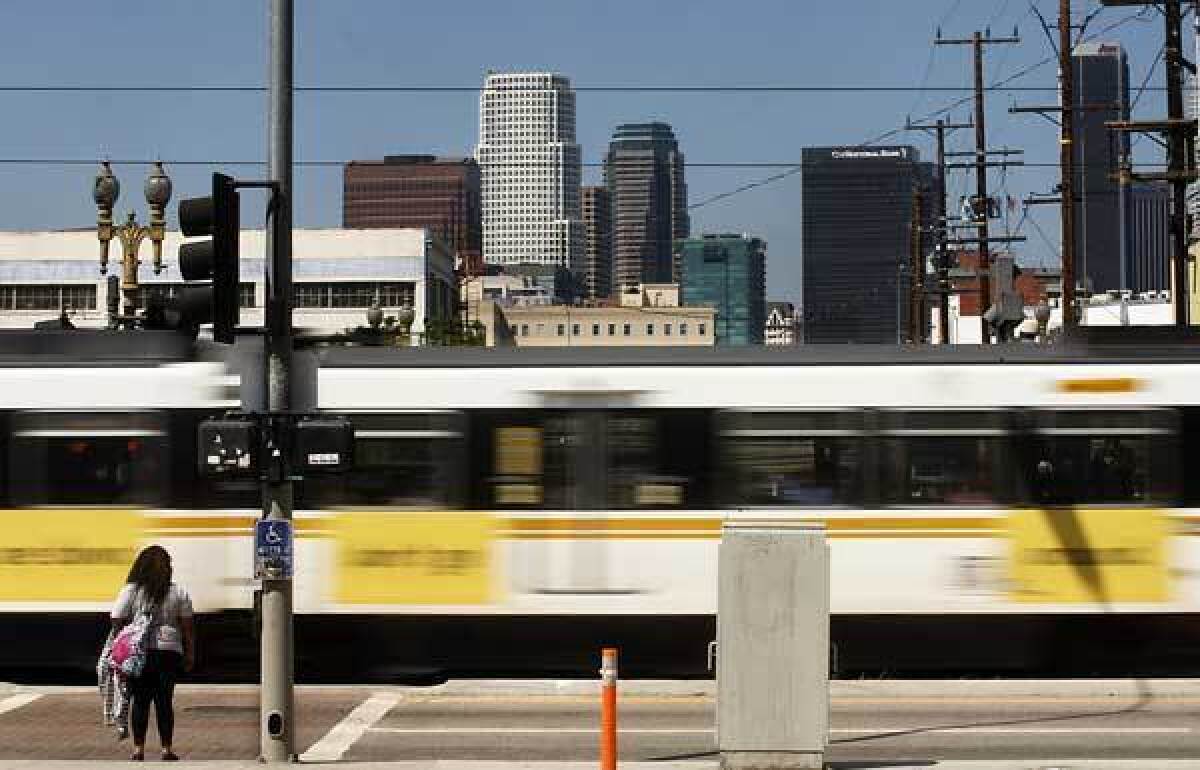L.A. County transit officials OK more funds for Blue Line safety

- Share via
Los Angeles County transit officials Thursday budgeted $6.78 million more for improvements on the Blue Line — one of the busiest light-rail lines in the nation, with 26 million riders annually and a history of accidents and fatalities.
There have been eight deaths along the Blue Line so far this year, at least four of which were suicides, according to Los Angeles County Metropolitan Transportation Authority officials.
The most recent fatality occurred Thursday about 12:45 a.m., when officials said a woman apparently tried to swerve her Hyundai around lowered gate arms at a crossing in Compton and was struck by a Blue Line train.
Last summer, county Supervisor Zev Yaroslavsky, a member of the Metro Board of Directors, warned his colleagues that the Blue Line was on track to have more fatalities in 2012 than any other year in its history. The 22-mile-long Blue Line, the county’s first light-rail line, opened in 1990 and travels from Long Beach to Los Angeles. In November, it averaged 93,201 weekday trips, the most ever for the line.
During its first dozen years, the Blue Line — which earned the dubious title of California’s deadliest rail transit route in 1999 with 10 fatalities and 50 accidents — averaged 50.9 accidents a year, but over the next decade that dropped to an average of 27.9 accidents annually.
Metro has made several safety improvements that have reduced accidents, including putting photo enforcement cameras at street crossings to discourage drivers from trying to race trains across the tracks.
The line had some of its lowest accident totals between 2008 and 2011. But Yaroslavsky earlier this year said he saw the numbers rising again in 2012 and seemed frustrated that the issue was still around, saying: “This has been an ongoing open ... sore for us.”
Also drawing attention to the issue were families such as the one that showed up at a board meeting wearing T-shirts with the picture of a dead teenage relative who had been struck by a Blue Line train while walking in Willowbrook.
After a Blue Line task force came up with several ideas to improve safety, the Metro board budgeted the money Thursday for more barriers, sidewalk improvements, new types of electric signs, better lighting around crossings, suicide prevention signs and audible warning devices, among other things.
Another factor fueling the safety changes were the results of a survey that showed that hundreds of Metro transit workers have concerns about their on-the-job safety. While most of the workers gave Metro high marks for safety, nearly half of the respondents still reported that they had had a close call that could have killed them or seriously injured someone.
Metro spokesman Marc Littman said that putting millions of dollars toward improvements shows that the agency is taking the issue seriously. He added that Art Leahy, Metro’s chief executive officer, has also been focused on decreasing a backlog of maintenance issues on the Blue Line and across the system, including purchasing new cars.
But Yaroslavsky is not convinced that the added millions of dollars will change much on the Blue Line.
“These are things that should have been done a long time ago and whether they’re going to be sufficient or not, I don’t know.... We had another fatality last night,” Yaroslavsky said Thursday. “It’s the most dangerous rail line in our system.”
“I want to see the number of fatalities and accidents along this line drop precipitously,” he said, adding that although it is difficult to stop suicides, “we’ve got to try.”
Mike Cano, transit deputy for county Supervisor and Metro Board Chairman Mike Antonovich, said that the agency lacks a strong culture of safety and that its leaders have been too focused on building projects and transit lines instead of ensuring the quality of existing operations.
“We’re not doing the groundwork in terms of figuring out what happens to fares, what happens to maintenance … what happens to make sure our systems are retrofit” and safe, Cano said, adding that no one wants to look back after a major transit accident and wish that more had been done.
In an unrelated agenda item Thursday, the board awarded an advertising contract worth more than $100 million over five years to CBS Outdoor Group, which after several rounds of negotiating and voting beat out Titan Outdoor, which had bid several million dollars more. Metro analysts said they were concerned about Titan’s finances.
And in a separate motion, Yaroslavsky said that next month he will ask the board to eliminate the $3 monthly maintenance fee assessed to those who use the new experimental ExpressLanes on the 110 and 10 freeways.
Times staff writer Dan Weikel contributed to this report.
More to Read
Sign up for Essential California
The most important California stories and recommendations in your inbox every morning.
You may occasionally receive promotional content from the Los Angeles Times.













